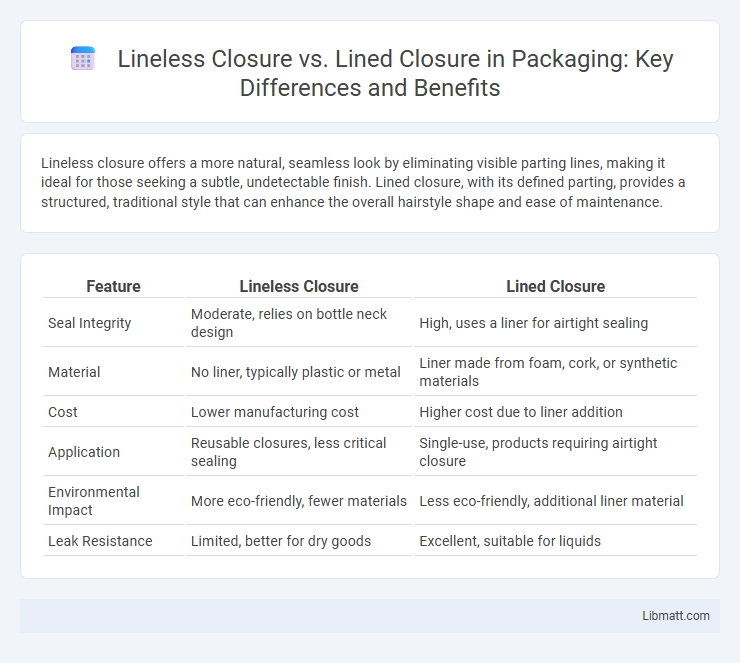Lineless closure offers a more natural, seamless look by eliminating visible parting lines, making it ideal for those seeking a subtle, undetectable finish. Lined closure, with its defined parting, provides a structured, traditional style that can enhance the overall hairstyle shape and ease of maintenance.
Table of Comparison
| Feature | Lineless Closure | Lined Closure |
|---|---|---|
| Seal Integrity | Moderate, relies on bottle neck design | High, uses a liner for airtight sealing |
| Material | No liner, typically plastic or metal | Liner made from foam, cork, or synthetic materials |
| Cost | Lower manufacturing cost | Higher cost due to liner addition |
| Application | Reusable closures, less critical sealing | Single-use, products requiring airtight closure |
| Environmental Impact | More eco-friendly, fewer materials | Less eco-friendly, additional liner material |
| Leak Resistance | Limited, better for dry goods | Excellent, suitable for liquids |
Introduction to Wound Closure Techniques
Lineless closure and lined closure represent two distinct wound closure techniques used to optimize healing and minimize scarring in surgical and traumatic wounds. Lineless closure employs methods such as tissue adhesives or absorbable sutures to achieve a seamless wound edge, reducing the risk of infection and improving cosmetic outcomes. In contrast, lined closure uses traditional suturing with visible stitches or staples, providing strong mechanical support but often resulting in more pronounced scarring and the need for suture removal.
Understanding Lineless Closure
Lineless closure refers to a technique in garment construction where seams are joined without visible stitching lines, creating a smooth and seamless appearance. This method enhances fabric drape and comfort by minimizing bulk, commonly used in high-end fashion and activewear. Understanding lineless closure is essential for designers aiming to produce sleek, modern garments with superior fit and aesthetic appeal.
What Is Lined Closure?
Lined closure refers to a type of hairpiece construction where the base is covered with a thin layer of fabric or lace to provide added durability and comfort. This lining reinforces the closure, making it more stable and less prone to tearing compared to lineless closures. Lined closures are commonly used for protective styles and give a more secure fit while maintaining a natural scalp appearance.
Key Differences: Lineless vs Lined Closure
Lineless closures offer a natural scalp appearance with minimal visible strands, providing a seamless blend for protective hairstyles, while lined closures incorporate a mesh or fabric base that mimics the scalp more distinctly, enhancing styling versatility. Lineless closures typically feature three-dimensional strands that create a more realistic hair flow, whereas lined closures provide structured parting options due to their defined base. These differences impact installation techniques, maintenance, and the overall aesthetic, with lineless closures favoring a more organic look and lined closures offering precision and durability.
Advantages of Lineless Closure
Lineless closure offers a seamless, smooth finish that enhances comfort by eliminating the bulk and potential irritation caused by traditional stitched lines. This type of closure improves the garment's aesthetic appeal with a sleek, invisible look that closely conforms to your body's natural contours. You gain greater flexibility and durability as lineless closures reduce the risk of fabric puckering and unraveling over time.
Benefits of Lined Closure
Lined closures offer superior durability and natural scalp appearance due to the fine mesh base that mimics the skin's texture, allowing for better breathability and comfort. This type of closure enhances the versatility of hairstyles by providing a seamless blend with natural hairlines and greater security during wear. The added strength and lace structure of lined closures reduce tension on hair follicles, promoting healthier hair growth and longevity of the wig or weave.
Clinical Applications and Indications
Lineless closure is primarily used in cosmetic surgery for minimizing visible scarring, ideal for facial and delicate skin areas requiring precise, tension-free wound edges. Lined closure is favored in surgeries needing structural reinforcement, such as abdominal or orthopedic procedures, providing strength and stability to deeper tissue layers. Clinical indications for lineless closure include superficial skin incisions and aesthetic repairs, while lined closure is indicated for complex wounds with high mechanical stress or risk of dehiscence.
Risks and Complications to Consider
Lineless closure often reduces the risk of visible scarring and skin tension, but may increase the chance of wound dehiscence or delayed healing due to lack of mechanical support. Lined closure, while providing stronger wound reinforcement with sutures or staples, carries a higher risk of infection, suture marks, and potential tissue ischemia. Surgeons must evaluate patient-specific factors such as skin type, wound location, and healing potential when choosing between lineless and lined closure techniques to minimize complications.
Patient Outcomes and Healing Time
Lineless closure techniques typically result in reduced scarring and faster healing times due to minimal skin trauma and precise wound edge alignment. In contrast, lined closure methods may increase the risk of infection and delayed healing because of the introduction of foreign materials such as sutures or staples. Clinical studies indicate that patients undergoing lineless closure often experience improved cosmetic outcomes and lower incidences of wound complications.
Choosing the Right Closure Technique
Choosing the right closure technique between lineless closure and lined closure depends on the specific application and desired aesthetic. Lineless closure offers a sleek, seamless finish ideal for minimalist designs, while lined closure provides added structure and durability, making it suitable for heavy-duty or professional use. Evaluating material type, garment purpose, and user comfort ensures the optimal closure method is selected for functionality and style.
Lineless closure vs lined closure Infographic

 libmatt.com
libmatt.com